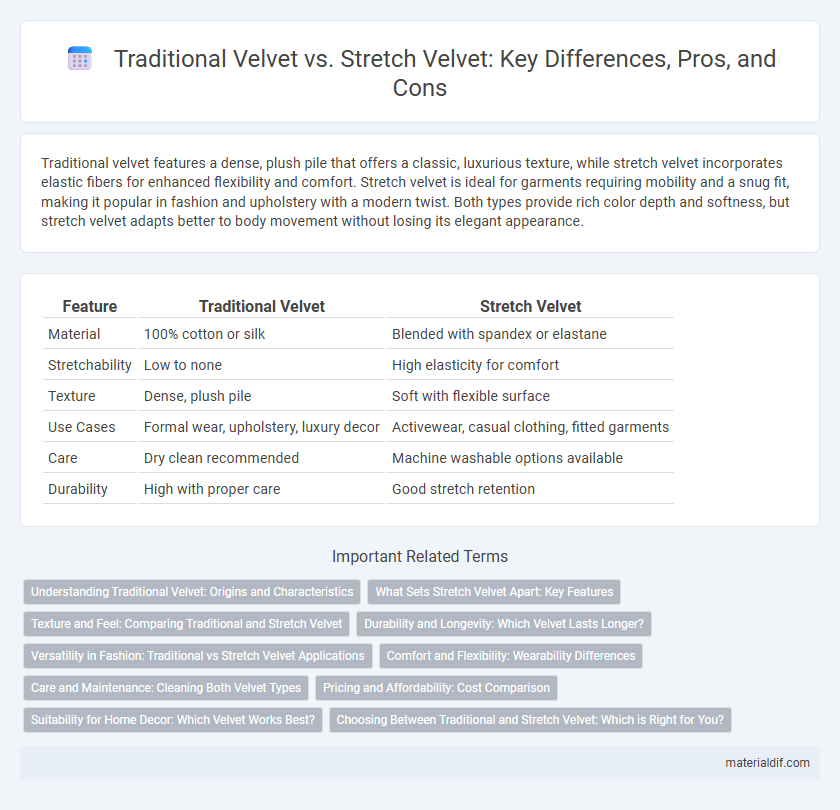Traditional velvet features a dense, plush pile that offers a classic, luxurious texture, while stretch velvet incorporates elastic fibers for enhanced flexibility and comfort. Stretch velvet is ideal for garments requiring mobility and a snug fit, making it popular in fashion and upholstery with a modern twist. Both types provide rich color depth and softness, but stretch velvet adapts better to body movement without losing its elegant appearance.
Table of Comparison
| Feature | Traditional Velvet | Stretch Velvet |
|---|---|---|
| Material | 100% cotton or silk | Blended with spandex or elastane |
| Stretchability | Low to none | High elasticity for comfort |
| Texture | Dense, plush pile | Soft with flexible surface |
| Use Cases | Formal wear, upholstery, luxury decor | Activewear, casual clothing, fitted garments |
| Care | Dry clean recommended | Machine washable options available |
| Durability | High with proper care | Good stretch retention |
Understanding Traditional Velvet: Origins and Characteristics
Traditional velvet, originating from ancient Asian and European textile crafts, is characterized by its dense pile and luxurious texture made primarily from silk or cotton. This fabric is known for its heavyweight, rich depth, and distinctive sheen, which results from the intricate weaving process that creates its pile surface. Unlike stretch velvet, traditional velvet lacks elasticity, making it ideal for formalwear and upholstery that require a stable, structured appearance.
What Sets Stretch Velvet Apart: Key Features
Stretch velvet distinguishes itself from traditional velvet through its enhanced elasticity, enabling greater flexibility and comfort in garments. Its fabric composition typically includes spandex or Lycra fibers, which provide superior stretch and recovery without compromising the plush texture. This unique blend allows for form-fitting designs and increased durability, making stretch velvet a preferred choice for activewear and contemporary fashion.
Texture and Feel: Comparing Traditional and Stretch Velvet
Traditional velvet features a dense pile with a rich, luxurious texture that feels soft and plush to the touch, often used for upholstery and formal garments due to its heavier weight. Stretch velvet incorporates elastane fibers, providing greater flexibility and a smoother, more forgiving feel that adapts to body contours, making it ideal for activewear and fitted clothing. Both types maintain the signature velvet sheen, but stretch velvet offers enhanced comfort and ease of movement without sacrificing the classic tactile richness.
Durability and Longevity: Which Velvet Lasts Longer?
Traditional velvet, woven from natural fibers like silk or cotton, offers exceptional durability due to its dense pile and strong thread structure, making it resistant to wear and tear over time. Stretch velvet, often made with synthetic blends such as spandex or elastane, provides flexibility but may be less durable, as the elastic fibers can degrade faster with frequent use. For long-lasting furniture or upholstery, traditional velvet generally outperforms stretch velvet in maintaining its texture and color retention.
Versatility in Fashion: Traditional vs Stretch Velvet Applications
Traditional velvet offers rich texture and durability suited for structured garments like jackets and evening gowns, excelling in classic, formal designs. Stretch velvet incorporates elastane fibers, providing flexibility and comfort ideal for body-hugging dresses, activewear, and modern fashion pieces that require movement. Both types enhance fashion versatility, with traditional velvet emphasizing elegance and stretch velvet maximizing adaptability and wearability.
Comfort and Flexibility: Wearability Differences
Traditional velvet offers a luxurious texture but tends to be less flexible and restrictive in movement due to its rigid weave and lack of elasticity. Stretch velvet incorporates spandex or elastane fibers, providing enhanced comfort by allowing greater freedom of movement and a snug, adaptable fit. The improved wearability of stretch velvet makes it ideal for active or fitted garments, whereas traditional velvet is better suited for structured, formal apparel.
Care and Maintenance: Cleaning Both Velvet Types
Traditional velvet requires dry cleaning to preserve its rich texture and prevent fabric damage, as water can cause stiffness and loss of softness. Stretch velvet, made with synthetic fibers, is often machine washable on a gentle cycle, but should be air-dried to maintain elasticity and avoid shrinking. Proper care prolongs the lifespan and vibrant appearance of both velvet types, ensuring softness and durability over time.
Pricing and Affordability: Cost Comparison
Traditional velvet generally commands higher prices due to its natural fiber content and more labor-intensive weaving process, making it less affordable for budget-conscious buyers. Stretch velvet, often made with synthetic blends like spandex or polyester, offers a more cost-effective option without compromising on luxurious texture and appearance. This affordability combined with enhanced flexibility makes stretch velvet increasingly popular for both fashion and upholstery applications.
Suitability for Home Decor: Which Velvet Works Best?
Traditional velvet offers a rich texture and durability ideal for classic home decor elements like draperies and upholstery, providing a timeless, luxurious look. Stretch velvet, known for its flexibility and softness, suits contemporary spaces with dynamic furniture shapes and items requiring extra comfort. Selecting the best velvet depends on the balance between aesthetic preferences and functional needs within your home environment.
Choosing Between Traditional and Stretch Velvet: Which is Right for You?
Traditional velvet offers a luxurious, dense pile with a rich texture that provides durability and classic elegance, making it ideal for upholstery and formal wear. Stretch velvet, crafted with added elastane fibers, delivers exceptional flexibility and comfort, perfect for fitted garments and active use. Selecting between traditional and stretch velvet depends on your need for either robust structure or flexible drape in your project.
Traditional Velvet vs Stretch Velvet Infographic

 materialdif.com
materialdif.com